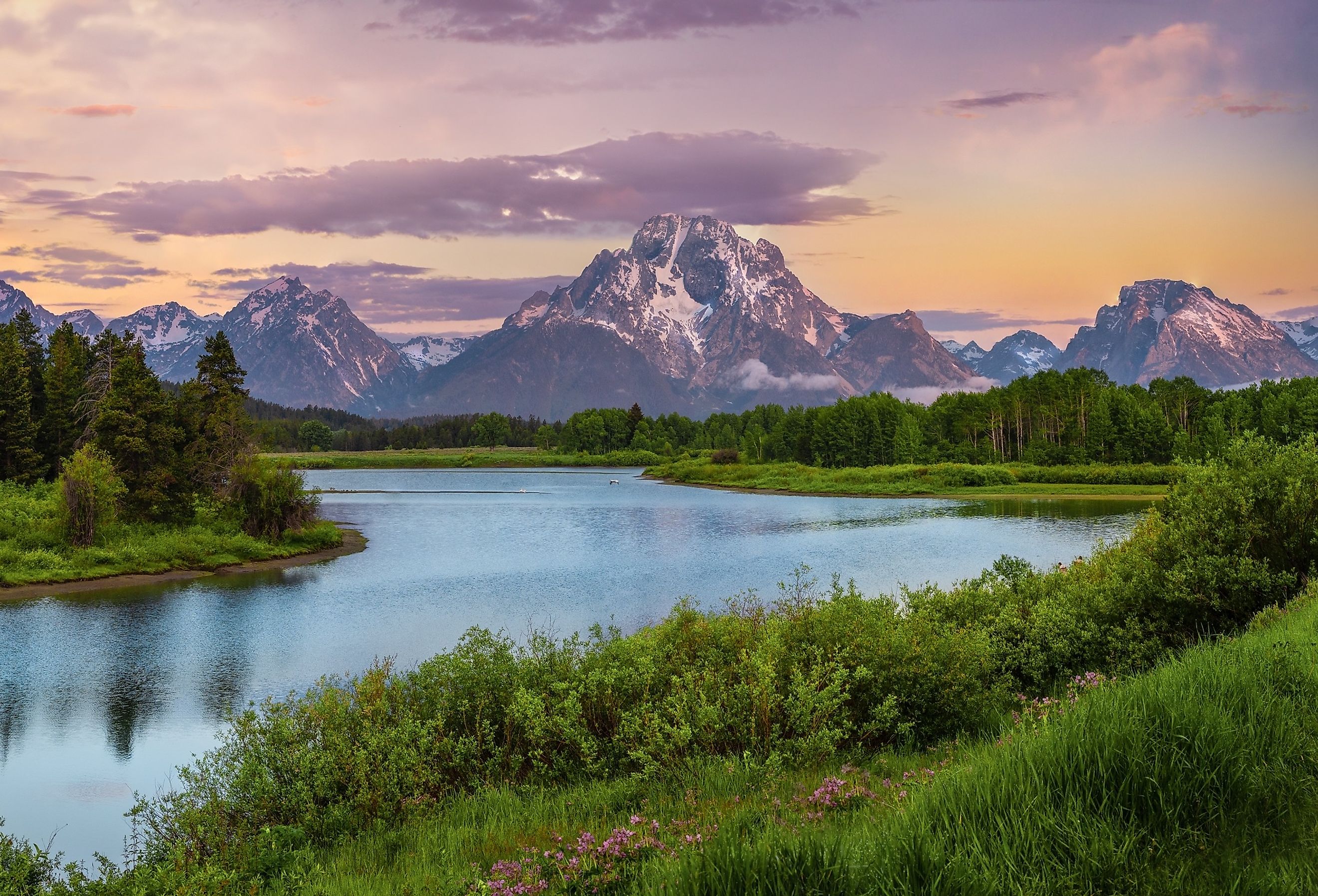
Grand Teton National Park
Often overshadowed by its insanely popular, older neighbor, Yellowstone, Grand Teton National Park is arguably just as scenic and worth an extended visit for anyone in Wyoming. This 310,000-acre park along the Teton Range is best known for its jagged peaks, diversity of wildlife (including grizzly and black bears, pronghorns, elk, and bison), extensive trail systems, white water rafting, and many more outdoor delights.
About 5 miles north of Jackson Hole and 10 miles south of Yellowstone National Park, Grand Teton is a stop you cannot miss. Read on to learn more about this destination so you can have the inside scoop before your next visit.
Geography
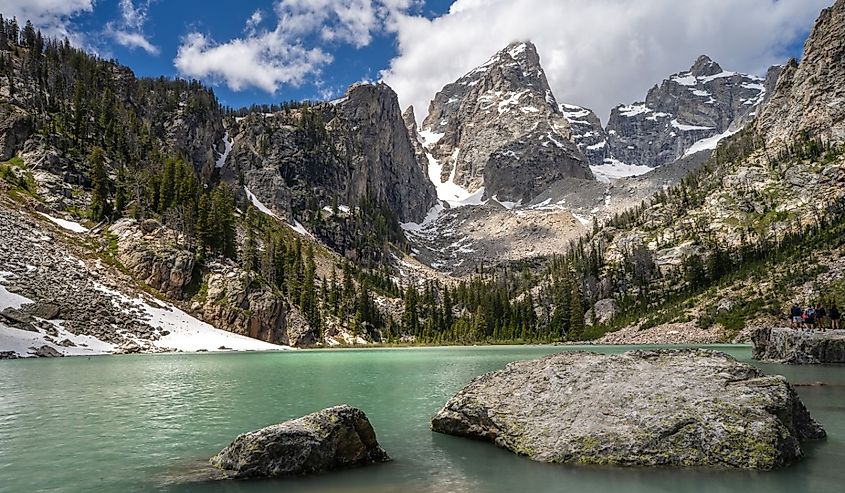
The sizable Grand Teton National Park covers a total of 310,000 acres in the northwestern corner of Wyoming, United States. It touches the border of Idaho and encompasses the Teton Mountain range, which is a part of the larger Rocky Mountains (a huge range that extends 3,000 miles from northern British Columbia, Canada, to the upper half of New Mexico). The highest mountain in the Teton Mountains, sharing its namesake with the park, is none other than Grand Teton, with a peak that soars up 13,700 feet.
Biomes in the park include coniferous forests, various wetlands, and sagebrush flats at its lower elevations and alpine forests, meadows, and alpine tundra at its higher points of elevation. An assortment of valleys are spread throughout the entire park, many of which feature maintained trails that can be explored.
Water
This park also features a number of lakes and rivers. The Snake River, which starts just north near Yellowstone National Park and ultimately discharges in the Columbia River, is the main waterway passing through Grand Teton. The Buffalo Fork River joins the Snake River on the eastern edge of the park. You will also find Cascade Creek, a gorgeous stream that starts from high up in the mountains at Solitude Lake and goes to Jenny Lake. Hidden Falls is a popular waterfall along Cascade Creek. Other Notable lakes within the borders of Grand Teton include Jackson Lake, Leigh Lake, Bradley Lake, Phelps Lake, String Lake, and Taggart Lake. Jackson Lake is the biggest, covering 25,540 acres. Also, the lakes of Grand Teton National Park are mainly glacier-fed, meaning they are quite cold year-round.
Grand Teton National Park is home to 11 named glaciers, the largest of which is Teton Glacier. Although seemingly gigantic in size, the many glaciers of Grand Teton are seeing a trend of shrinking due to a warming average climate. Because of this, the exact sizes of these icy behemoths vary greatly from season to season, and year to year.
Climate
Grand Teton National Park is classified as a humid continental climate and usually sees four distinct seasons every year. It generally has moderately warm summers, a short but sweet fall, cold and very snowy winters, and mild springs (although spring here may still see significant snowfall in its early months).
Like many mountainous regions in the northwestern part of the country, the weather in this park can often be unpredictable. Massive afternoon showers can appear from over the mountains in the summer and fall, and clear days can quickly turn to gigantic snowfalls. The winter of 2022 to 2023 alone saw a whopping 590 inches of snow hit the ground!
Wildlife
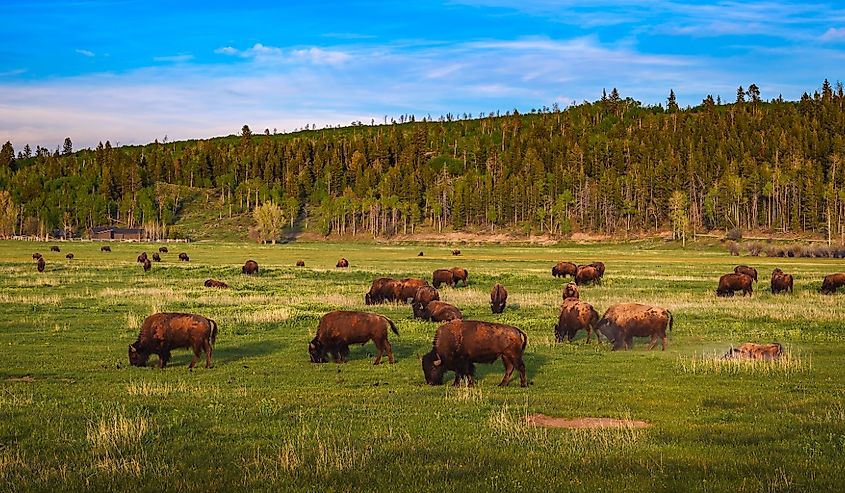
As with most national parks, Grand Teton is a zone intended to protect the sensitive wildlife within it. From plants to animals, many flock here every year to witness the amazing variety of life that calls this rugged place home.
Animals
Grand Teton National Park is perhaps most notable for its populations of mammals, constituting 61 different species in total. Grizzly bears, black bears, gray wolves, Canadian lynx, and more common species like red foxes and coyotes make up the bulk of the larger predators in the park. Wolverines and mountain lions are more elusive but have been sighted too. Large herbivores here consist mainly of deer, moose, elk, bison, and pronghorn. A few species of squirrels, chipmunks, pine martins, badgers, and even weasels, can be found, although martins, badgers, and weasels are fairly rare.
Birdwatching is a popular activity in Grand Teton, with many birds of all sizes migrating here throughout the year. Look out for the iconic bald eagle, and look even harder for the calliope hummingbird, North America's smallest bird. On the other hand, check the lakes for trumpeter swans, North America's largest waterfowl. Other species tend to stick to the forests, like the sage grouse and the colorful Western Tanger.
The bodies of water in and around Grand Teton provide habitats to a number of fish, reptiles, and insects too. The cold waters make an ideal habitat for fish species like trout, mountain whitefish, dace, suckers, and several others.
Even in this mountainous, often cold environment, three species of snakes live here, including the valley garter snake, wandering garter snake, and rubber boa, and one species of lizard—the sagebrush lizard. Luckily, none of these creatures are venomous.
Plants
A diverse range of plant life has adapted to the varying elevations and habitats in Grand Teton. At lower elevations, sagebrush flats are prevalent, dominated by big sagebrush, along with native grasses and wildflowers such as lupine and balsamroot.
As the elevation increases, the park's forests become denser, primarily composed of lodgepole pine, Engelmann spruce, and Douglas fir. These forests provide habitat for a multitude of understory plants too, including huckleberries, thimbleberries, and a variety of ferns and mosses.
The subalpine and alpine zones, characterized by harsh conditions and shorter growing seasons, still support a selection of resilient plant species. Subalpine meadows wow hikers during the blooming season with flowers like Indian paintbrush (Wyoming's state flower), alpine forget-me-not, and purple aster. Above the tree line, the alpine tundra is home to hardy species such as cushion plants, which form mat-like clusters to help withstand the cold and wind at extreme elevations. Delicate alpine sunflower and moss campion clinging to rocky outcrops can also be found at similar heights.
The park's wetlands, fed mainly by the Snake River and the glacial lakes, support willows, cottonwoods, and aquatic plants like pond lilies and cattails.
History
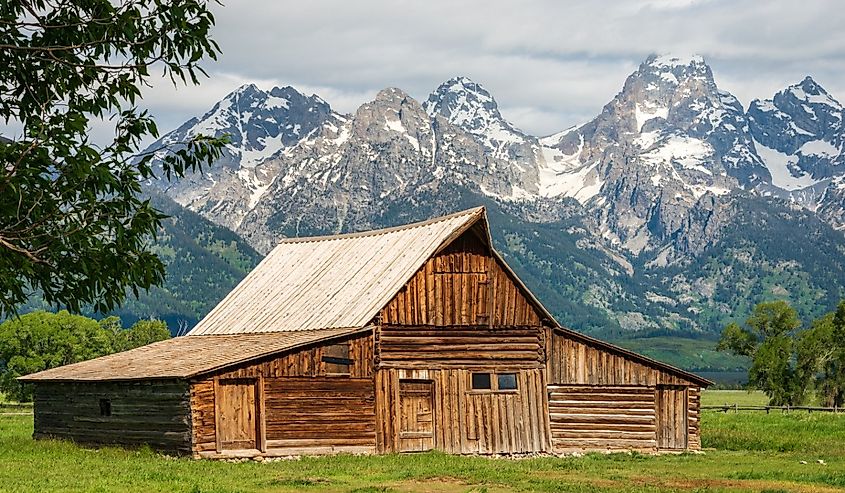
Humans are thought to have inhabited the Grand Teton area for more than 11,000 years. The various Shoshone tribes used the area as a hunting ground and passed through it to travel to other regions. Still, little evidence has been found of permanent settlements before the arrival of European/American explorers/settlers.
It is likely that the first non-natives who laid eyes on this portion of Wyoming were those who were involved in the famed Louis and Clarke expedition somewhere between 1807 and 1808. It was an American government-funded journey with the intention of gaining information about the continent's interior and Pacific coast.
Fur trappers, farmers, ranchers, and military installations began popping up later in the century, leading to some of the area's first permanent settlements, the most well-known of which was Jackson. This town continues to grow to this day (but mainly for tourism these days as opposed to resource extraction and agriculture).
The Teton Mountains were named by early French-Canadian trappers who arrived in the area. Presumably lonely on their travels, they noted that the prominent peaks resembled large breasts—"grand tetons" in French.
The park itself was officially created in 1929, with expansions being made over the coming decades, most notably in 1950 when Congress decided to combine Grand Teton with other nearby parks along with donated land (primarily from John D. Rockefeller), giving it the borders it has today.
Tourism and Amenities
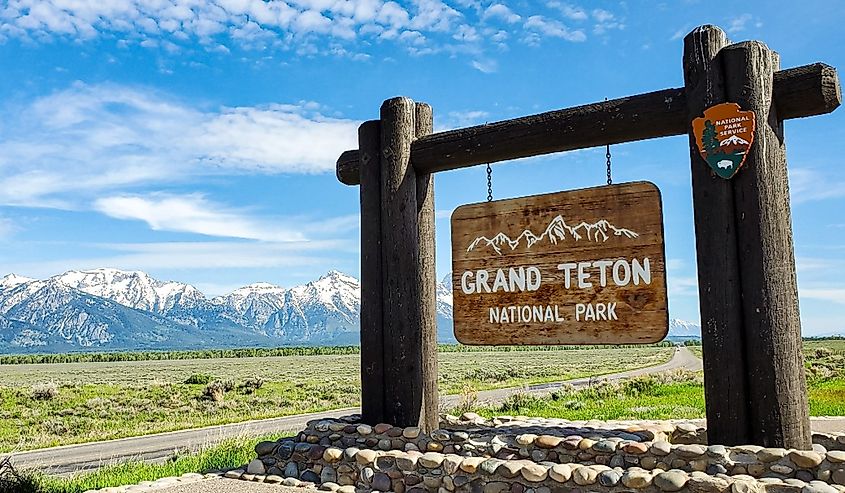
Grand Teton National Park is a prime destination for tourists seeking outdoor adventure and natural beauty. It is one of the most visited national parks in the United States, with an average of over 3 million visitors per year.
Activities are plentiful in the park. Hiking trails, like the scenic Cascade Canyon Trail and the strenuous hike up to Lake Solitude, offer its hikers a way to explore the terrain. Boating and fishing are popular on Jackson and Jenny Lakes, with boat rentals and guided fishing tours available. For those interested in wildlife, there are several trails and observation decks throughout that are likely to take you closer to many of the park's plants and animals (just be sure to keep a safe distance always). For the lazy, animal sightings at the side of the park's roads and highways are quite common too.
Lodging options within the park range from campgrounds to historic lodges. The Jackson Lake Lodge, Jenny Lake Lodge, and Signal Mountain Lodge provide comfortable accommodations with breathtaking views of the Teton Range. Numerous campgrounds, such as the popular Gros Ventre and Colter Bay, will offer a more "rustic" experience for those preferring to sleep under the stars. The nearby town of Jackson serves as a gateway to the park and presents additional amenities, including a wide range of dining options, hotels, museums, and outfitters.
In the winter, the park transforms into a snowy wonderland, and popular activities include cross-country skiing, snowshoeing, and guided snowmobile tours in the nearby Bridger-Teton National Forest.











